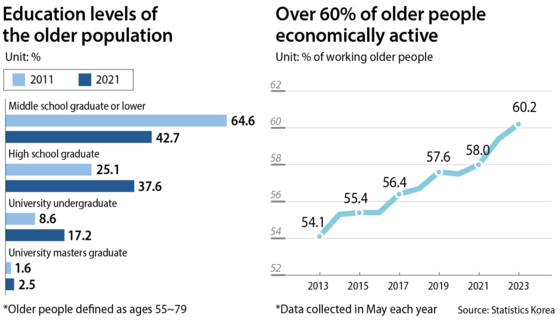Older Koreans flock to work as labor shortage solution
![An old man takes a rest in the Tapgol Park in central Seoul on July 25. [NEWS1]](https://koreajoongangdaily.joins.com/data/photo/2023/10/22/c028daed-6725-49b4-bcff-ec633337bda6.jpg)
An old man takes a rest in the Tapgol Park in central Seoul on July 25. [NEWS1]
This means six out of 10 older people are either working or actively in the process of finding employment. It is the highest rate of labor force participation by older adults to date.
The older adult labor population has increased from 5,872,000 people in 2013 to 9,321,000 people this year, according to the “Supplementary Results of the Economically Active Population Survey for the Old Population” collected by Statistics Korea.
Based on the acceleration rate, the number is expected to creep up to more than 10 million next year. This increase is primarily because the baby boomer generation, born between 1955 and 1963, has started entering the older adult demographic.
The economic activity participation rate among those aged 55 to 79 is 60.2 percent. It is the largest number to date since relevant statistics were first collected in 2005.
This can be explained as the combined result of the increase in physically healthier older people with higher life expectancy, and the increase in economic burdens such as living costs.
But most of the jobs for older adults are for work that require little or no experience or training, or consist of routine tasks. A total of 23.2 percent of the older workforce do unskilled work, and 13.9 percent work in the service industry.
This means that a large number of older workers are working in public sector jobs created and partially funded by the government, or in unskilled labor.

Experts say that the number of highly educated and skilled older workers is increasing. According to the “Current Status and Improvement Measures for the Old People Labor Market” report published last year by the Korea Employment Information Service (KEIS), 64.6 percent of the older workforce had received a middle school education or lower in 2011.
The proportion decreased to 42.7 percent in 2021. On the other hand, the proportion of high school graduates increased from 25.1 percent to 37.6 percent, and university graduates increased from 8.6 percent to 17.2 percent.
The percentage of workers who worked in high-skilled labor jobs before retirement also increased. Data collected for the “longest held occupation” from the older adults in the same time period showed the following changes: skilled agricultural, forestry and fishery workers decreased from 6.3 percent to 1.8 percent, sales workers decreased from 13.9 percent to 10.6 percent, professionals and related workers increased from 6.2 percent to 9.3 percent, and managers increased from 4.7 percent to 7.2 percent.
“It is very likely that the level of human capital of the older workers is higher than in the past,” said KEIS researcher Ahn Jun-ki, who conducted the study.
A greater number of older female adults want to work. According to Statistic Korea’s supplementary results on the older population, the increase in the percentage of women wanting to work in the future — 47.8 percent in 2011 to 60.3 percent in 2021 — was higher than that of the men, which increased from 74 percent to 77.3 percent.
“The older women from the baby boomer generation who are currently pouring into the labor market have completely different educational backgrounds, incomes, and economic and social status than in the past. It has been a generational paradigm shift,” said Kim Young-sun, a professor at the Graduate School of East-West Medical Science at Kyung Hee University.
Experts say that such newcomers can be a solution to the shortage crisis in the labor market caused by the declining population rate. “Raising the birthrate takes a long time. Meanwhile, in order to solve the problem of a declining economically productive population, initiatives that make use of the older population need to be made,” said Kim.
Ahn also emphasizes the need for job initiatives that take into consideration the supply and characteristics of older adults. The need for the development of a job model for recently retired workers that utilizes highly educated human capital, the expansion of customized support programs for older women, and the implementation of a flexible working environment were given as examples.
“There are people who want flexible working environments for reasons such as health care and time management. It's necessary that a lot of part-time jobs that make use of professional skills be made,” said Ahn.
BY LEE WOO-LIM, KIM JU-YEON [kim.juyeon2@joongang.co.kr]










with the Korea JoongAng Daily
To write comments, please log in to one of the accounts.
Standards Board Policy (0/250자)